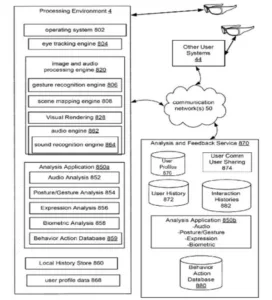In recent news Microsoft and Apple were tapped as filing and receiving patents that describe mood or emotion sensing as part of the patents.
Microsoft received a patent called “Wearable Emotion Detection Feedback System” (US Patent # 9,019,174 B2). This patent describes a possible way to detect the mood of people around the wearer of augmented reality glasses, like HoloLens for example, or the user of a smartphone with a camera. The following flowchart describes what Microsoft wants to do with such data capturing devices.
The company will run analysis software on the captured images and compare it against a set of databases to derive the emotional state of the target. From a personal standpoint it will assist users in reading the mood of other people. While this may be helpful for people who are particularly bad at reading other people and interpreting body language, it also holds the risk of a miscalculation on the side of the computing device.
(As a side note, during Microsoft’s Build 2015 conference, it showed off a nifty little website (how-old.net) that guesses the age of a face from any photo. A nice little party entertainment as it seems. It does show, however that Microsoft has been working along the lines of person analysis.)
At the same time, Apple applied for a patent called “INFERRING USER MOOD BASED ON USER AND GROUP CHARACTERISTIC DATA” (US Patent Application # 20140025620). In contrast to the Microsoft patent, the Apple patent application describes not only how the system derives the user’s mood by comparing sensor data to a user specific profile, but also how a server may select content based on the mood of the user.
While less specific on how to arrive at the emotional status, it goes one step further in that it suggests what to do with such data.
A search for patent applications for “mood or emotion” in the US patent application database returns over 8,000 hits since March 2001. It seems the function of personal computing and content delivery is moving to a new field that may change the way we interact with CE devices in the future. – NH

